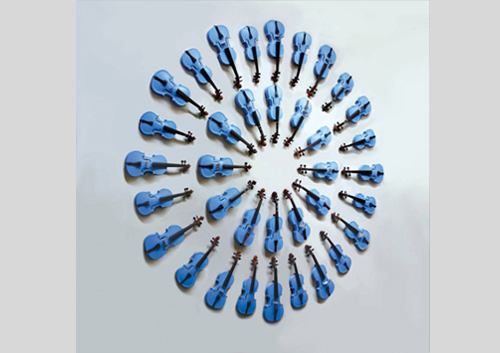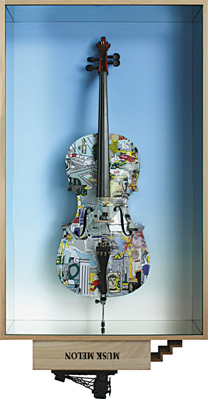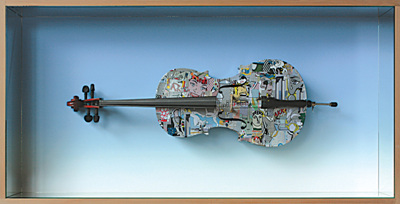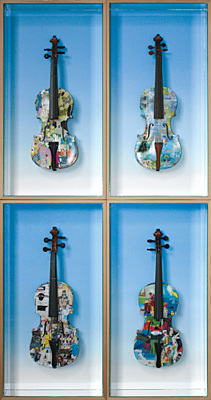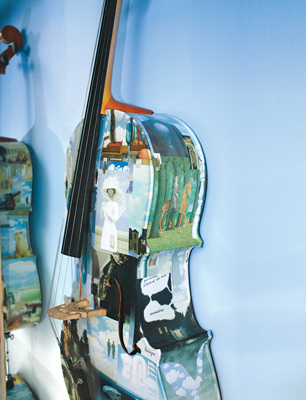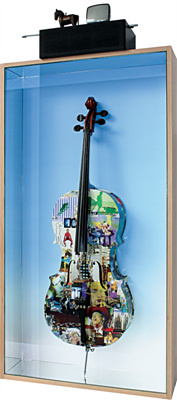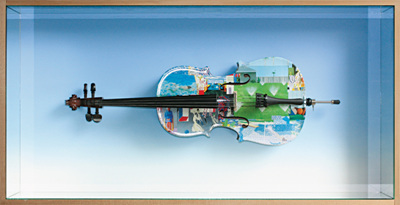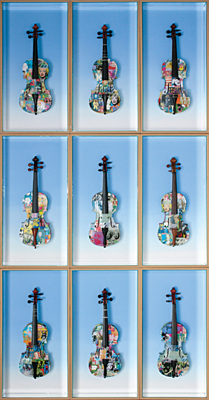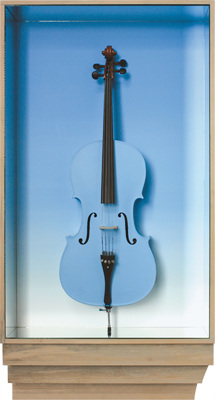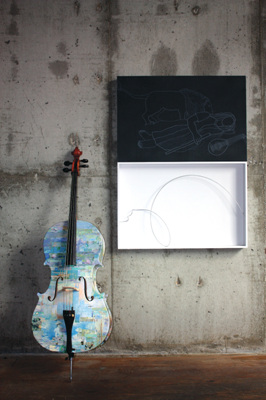Han, Man Young
Han, Man Young
The Sensuous Structure of Appropriation & Originality
Kim, Mi-Jin (Art Director of Seoul Arts Center, Associate Professor of Art at Hong-ik University)
Han, Man-Young is an artist who is creating his own art world, which is always ahead of the times, by deconstructing old masters and objets, the flat and three dimensionality, time and space and reconstructing them into his works of art where the real and unreal coexist. Recently, he is making a serial works with rectangular boxes inside of which are decorated with 4 glass panels which create a blank space, the symbol of sky, and a violin made up of collages of masterpieces.
Han has been choosing and assembling lots of objects until now. This time, he found the ensemble of the visual and the auditory art from the musical instrument of violin which has the perfect formal beauty in itself. The violin which makes the most “splendid” sounds among all the string instruments now became a material for art stripped away its original uses and features. Han covered it up with art works of grand masters in the history of art such as Andy Warhol, Claude Monet, Namjun Paik, and Roy Lichtenstein. He printed out the images and made a collage of them. This could be seen as the sensuous extension of Han’s art world. He added the auditory sense to the works where the real and ideal coexist which he had been making by juxtaposing many objets with various originations and occurrences.
The violin which has been played by so many people in so many places now becomes a nostalgic & analog symbol of accumulated experiences (history) and memories of players, audiences, concert halls, music, craftsmen, and so on. Pieces of famous paintings covering it up symbolizes the current status of the “divine” historical value which became information inside the palms of general public in the form of images. Here, beneath the surface, there is another metaphor and paradox that the copies of paintings, the “original form” of visual art, are coated on the mass produced instrument of violin containing the “original form” of music. Symbols of high culture remains as fragmentary language and abstraction, the signified of originality of arts; the industrial products of violin and copies of masterpieces work as the signifier of the real world covered up with various imitations and appropriations.
Han’s works expect us to interpretate the game of multiple concepts between the society, literature, and art. His labors (“hands”) and senses turned the manufactured product into an work of art with unique formal features. This also means his putting the text of reproduction, the paradigm of postmodernism, back to the value of the originality of modernism which pursued the metaphysical values and creative art through the subjective status and senses of an artist. However, the work is different from the earlier works which expressed the value of modernism in the material abstractiveness. It could be said as an alternative work of modernism after experiencing the debates on the range of appropriation of various media and genres and freed from them.
The copied prints of great masters which once were treated as the avant-garde of their own period put the new clothes of post structuralism (fragmentation, rupture and discontinuation) on and are attached to the instrument which has a different cultural and theoretical backgrounds and experiences in a natural way. The result is an art of modernism which has the kitsch and original features at the same time.
The assembling of manufactured product and lots of images makes an apparent contrast with the empty background, the sky. This shows the mixture has the aesthetic materiality which could confront the nature. With this, the whole picture gains the balance of tenseness and harmony, and has a refined formality.
In Han’s most recent works, the fragments of masterpieces are making a formative beauty on the three-dimensional surface of violin which is round but sharp and very sensitive. The “should be” uniformed and objective concepts and thoughts which he talked of meet a different world and try to find their own locations inside to complete the aesthetic composition. They are newly organized in the space and create an ultimate unification of formative arts.
his work is reproduced and installed alone or attached to others according to the exhibition space. Here, as a subject is multiplied, the originality once again experiences the process of “self-split”. In addition, as the mirrors inside the rectangular box reflects the images, the multiplied forms have an infinite extension into four directions inside the kaleidoscope-like space and visualize the wavelength of sound of music. The work looks totally different according to where the audiences are. From the front, it looks like a rectangular box with an objet just like his earlier works. However, from a little different angle, as the four sided mirror reflects back everything, the audiences, subjects, works, paintings, frames, the flat and three dimensionality are infinitely transformed. With the transformation, the audiences could experience the world of “simulation”.
an, Man-Young creates a coexistence of historical space and invisible and unlimited Cyber spaces which we are experiencing through the mediation of internet. Han who has been appropriating the avant-garde works in the history of art and trying to express the existential boundary of art and life, traditions and present time, reality and the ideal, painting and sculpture might have already predicted the period when the abstract time and space of “the ideal, past, and surreal” becomes present through the “Cyber” media. He always juxtaposes the heterogeneous elements to suggest that the world of existence is not fragmented or disconnected but synthesized and integrated. In this exhibition, Han shows the complicated conditions of the present in a sophisticated and modest language of “simple purity”. This is the result of his experiences of the media world through life and work. This is the result of his long-time endurance of repeated experiments with one subject matter.


